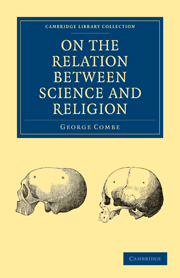
-
Select format
-
- Publisher:
- Cambridge University Press
- Publication date:
- August 2010
- July 2009
- ISBN:
- 9780511693991
- 9781108004510
- Dimensions:
- Weight & Pages:
- Dimensions:
- (216 x 140 mm)
- Weight & Pages:
- 0.41kg, 324 Pages
You may already have access via personal or institutional login
Book description
George Combe (1788-1858) rose from humble origins to tour widely in Europe and the United States lecturing on phrenology, the popular Victorian belief that character traits were determined by the configuration of the skull. His most famous book, The Constitution of Man, published in 1828, put forward a naturalist agenda and sold approximately 350,000 copies. In 1857, Combe published On the Relation between Science and Religion. He denounces dogmatism and sectarianism, and argues insistently that religious leaders should encourage the study of science as revealing God's governance. He proposes that phrenology sheds light on the divine purpose and moral laws through an improved understanding of the human mind, and criticises both scientists and religious leaders who maintain that higher thought has nothing to do with the brain. His book ranges widely across the concerns of Victorian educated classes, and addresses questions many of which still resonate today.
Contents
Metrics
Full text views
Full text views help Loading metrics...
Loading metrics...
* Views captured on Cambridge Core between #date#. This data will be updated every 24 hours.
Usage data cannot currently be displayed.
Accessibility standard: Unknown
Why this information is here
This section outlines the accessibility features of this content - including support for screen readers, full keyboard navigation and high-contrast display options. This may not be relevant for you.
Accessibility Information
Accessibility compliance for the PDF of this book is currently unknown and may be updated in the future.

